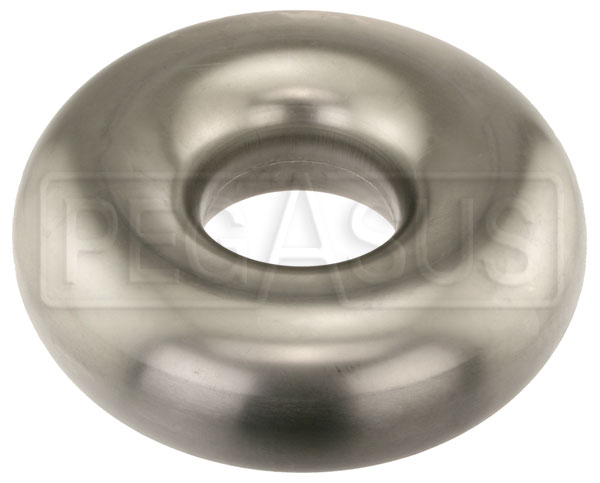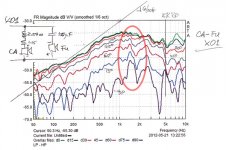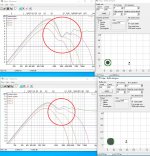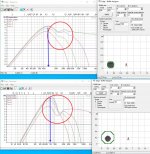Stacked sheets of 1in thick XPS foam sculpted with a knife might be good too. Makes an awful mess when sanded though. Will have to think about it. If it works, my cabinet maker is very good with a lathe and has been looking for speakers that use it.
Something like this torus bowl for snacks.


These are all DIY woodworking projects so not for sale. This would make a beautiful speaker though.
In the Torus thread I saw a link to these hollow stainless steel donuts. Looks like a 3.5in OD of the toroidal section and 3.5in center radius could work? $80, 12in dia with 4in hole might just be perfect for a high tech diffraction free dipole. All things considered, $100 for a unique baffle like this is not a bad price.
Tube Full-Round Donut, Stainless Steel | Pegasus Auto Racing Supplies

Something like this torus bowl for snacks.


These are all DIY woodworking projects so not for sale. This would make a beautiful speaker though.
In the Torus thread I saw a link to these hollow stainless steel donuts. Looks like a 3.5in OD of the toroidal section and 3.5in center radius could work? $80, 12in dia with 4in hole might just be perfect for a high tech diffraction free dipole. All things considered, $100 for a unique baffle like this is not a bad price.
Tube Full-Round Donut, Stainless Steel | Pegasus Auto Racing Supplies

Last edited:
The "trick" I'm asking about is mitigation of the on axis nulls.
A wheelbarrow tyre has quite a good shape and little tread on some.
A wheelbarrow tyre has quite a good shape and little tread on some.
Last edited:
It could be that something like this is available in different sizes 🙂.
com-four(R) 1x potting compound for flower arrangements in ring form - floral foam for fresh flowers - sponge for crafting for wedding, Easter and birthday: Amazon.co.uk: Kitchen & Home
com-four(R) 1x potting compound for flower arrangements in ring form - floral foam for fresh flowers - sponge for crafting for wedding, Easter and birthday: Amazon.co.uk: Kitchen & Home
Another part of the idea, and why I used that specific diagram, is to use two drivers back to back, this increases distance again which may, or may not, cause problems, but it has the advantage of identical front and rear radiation.
I seem to recall that using two woofers that are joined by/in a short tunnel will cause problems above some frequency. I think this was established from studies of compound isobarik subwoofers. The air inside the "tube" connecting front and back woofers is not an incompressible fluid, so there is some wave propagation. Due the distance, the phase of the wave will rotate and eventually at a high enough frequency you have out of phase combination that causes interference with the "other" woofer.
For the dipole torus, the two woofer idea could work well at LF, but there arent any real problems that need to be solves using two woofers back-to-back compared to just using one. At HF the two woofers will probably cause more problems than just using one. Not sure it is worth it. Also, you are getting away from the "no box" advantages of OB systems.
Hmm guys,
to make it simple, the problem with wide (full) range dipole radiators is always the transition from ideal dipole pattern to the range where directivity starts to get gradually narrower, because of transducer's diameter. This transition range has almost omnipole radiation pattern because of mixed diffractions. Period.
Numerous tricks have been used to make this smoother (in on-axis measurement) eg. rectangular baffle, edge contouring, horn. All these mean higher baffle radius and lower dipole peak! And the transition issue remains!
Flat/planar radiator is ideal for dipole. Cones with backside magnet are very bad above dipole peak. Double opposing cones only add problems and complexity!
This is why a multiway dipole is the way to go - ideally we should use only "pure" dipole range of each radiator, but this is impossible to achieve above 4-6kHz in real life. LX521, Nao NoteII, StigErik's dipoles and my AINOgradient Neo83 and some protos of Rudolf Finke and Charlie Laub are best examples.
This is directivity of a 3" cone driver, wfrom SL with my add-ons, but the no-directivity issue is evident!
to make it simple, the problem with wide (full) range dipole radiators is always the transition from ideal dipole pattern to the range where directivity starts to get gradually narrower, because of transducer's diameter. This transition range has almost omnipole radiation pattern because of mixed diffractions. Period.
Numerous tricks have been used to make this smoother (in on-axis measurement) eg. rectangular baffle, edge contouring, horn. All these mean higher baffle radius and lower dipole peak! And the transition issue remains!
Flat/planar radiator is ideal for dipole. Cones with backside magnet are very bad above dipole peak. Double opposing cones only add problems and complexity!
This is why a multiway dipole is the way to go - ideally we should use only "pure" dipole range of each radiator, but this is impossible to achieve above 4-6kHz in real life. LX521, Nao NoteII, StigErik's dipoles and my AINOgradient Neo83 and some protos of Rudolf Finke and Charlie Laub are best examples.
This is directivity of a 3" cone driver, wfrom SL with my add-ons, but the no-directivity issue is evident!
Attachments
Last edited:
How will modal propagation within the box, and back to the driver, in the case of two back to back drivers in a tube.. be any different than a single driver in a similar shaped box?I seem to recall that using two woofers that are joined by/in a short tunnel will cause problems above some frequency.
Could most of those problems be solved with a lossy enclosure (torus) Charlie? COMFORTNIGHTS Surgical Ring Cushion (donut cushion) (piles/pile): Amazon.co.uk: Health & Personal Care
Edge excersice to show what I was talking about - same baffle different radiator.
Please let me remind that Edge uses ideal planar radiator - with a cone we get it's geometry and resonance irregularities added above dipole peak!
Please let me remind that Edge uses ideal planar radiator - with a cone we get it's geometry and resonance irregularities added above dipole peak!
Attachments
So many compromises 😉 There's the problem of increased separation but the advantage of identical radiation front and rear, something Linkwitz didn't seem all that concerned with? I suppose it's about identifying what is most important. Would I be right in assuming that, to you, it's constant directivity?Flat/planar radiator is ideal for dipole. Cones with backside magnet are very bad above dipole peak. Double opposing cones only add problems and complexity!
Last edited:
Edge excersice to show what I was talking about - same baffle different radiator.
Please let me remind that Edge uses ideal planar radiator - with a cone we get it's geometry and resonance irregularities added above dipole peak!
Does this mean a toroid is not good because it necessarily adds baffle size?
I understand that, but the sims are of a torus baffle.If I use a driver, without baffle (nude), it doesn't have any on axis nulls either.
Does this mean a toroid is not good because it necessarily adds baffle size?
I don't say it's not good, but it will add baffle diameter compared to a nude one. It might be better than a flat baffle, but I can't sim it. OllBoll has demonstrated that felt baffle helps, toroid might do the same, but bot at the expence of shifting dipole peak lower.
It was late, I made only a sim with different radiator diameter, not with different baffle r.
From the sims Allen and I have done with this Ripple Tank Simulation the off axis null seems to have been spread out at the cost of it's depth.
They have these 12" beach tires on ebay, $50 - $75 a piece.
Those look good except perhaps the sidewall is a bit flat, an element of waveguide also seems to help, although the rims may pull together for a better shape, that's what I found with a wheelbarrow tyre.
Do you think the ripple tank simulation isn't accurate enough? It seems very sensitive to changes in position of the components that make up the obstructions. Do you know of a better simulation tool for the job?
You can only see one frequency at a time, it isn't specified so everything is relative, wavelength to baffle size, so it's far from ideal.
- Home
- Loudspeakers
- Full Range
- Did Siegfried Linkwitz miss a trick?




